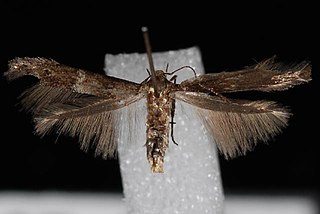The Cosmopterigidae are a family of insects in the order Lepidoptera. These are small moths with narrow wings whose tiny larvae feed internally on the leaves, seeds and stems of their host plants. About 1500 species are described. The taxonomic family is most diverse in the Australian and Pacific region with about 780 species.

Sorhagenia is a genus of moths in the family Cosmopterigidae. The name honours Ludwig Friedrich Sorhagen.

Sorhagenia janiszewskae is a moth in the family Cosmopterigidae. It is found from Great Britain to Russia and from Fennoscandia to France, Switzerland, Austria, Croatia, Hungary and Romania. It has also been reported from Portugal, the Caucasus and western Transcaucasia.

Sorhagenia lophyrella is a moth in the family Cosmopterigidae. It is found in most of Europe, Asia Minor and the Caucasus.
Sorhagenia reconditella is a moth in the family Cosmopterigidae. It is found in Greece and on Cyprus.

Sorhagenia rhamniella is a moth in the family Cosmopterigidae. It is found in most of Europe, except the Balkan Peninsula.
The Chrysopeleiinae are a subfamily of the Cosmopterigidae, although some authors treat it as a full family, the Chrysopeleiidae.
Sorhagenia taurensis is a moth in the family Cosmopterigidae. It is found in Asia Minor.
Sorhagenia baucidis is a moth in the family Cosmopterigidae. It was described by Ronald W. Hodges in 1969. It is found in North America, where it has been recorded from Illinois and Saskatchewan.
Sorhagenia cracens is a moth in the family Cosmopterigidae. It was described by Ronald W. Hodges in 1978. It is found in North America, where it has been recorded from Idaho.
Sorhagenia daedala is a moth in the family Cosmopterigidae. It was described by Ronald W. Hodges in 1964. It is found in North America, where it has been recorded from California.
Sorhagenia dahurica is a moth in the family Cosmopterigidae. It was described by Sinev in 1986. It is found in Russia.
Sorhagenia maurella is a moth in the family Cosmopterigidae. It was described by Sinev in 1993. It is found in Russia.

Sorhagenia nimbosus, the midrib gall moth, is a moth in the family Cosmopterigidae. It was described by Annette Frances Braun in 1915. It is found in North America, where it has been recorded from British Columbia, Washington and California.
Sorhagenia pexa is a moth in the family Cosmopterigidae. It was described by Ronald W. Hodges in 1969. It is found in North America, where it has been recorded from Texas, Arkansas and Illinois.
Sorhagenia vicariella is a moth in the family Cosmopterigidae. It was described by Sinev in 1993. It is found in Russia.
Sorhagenia riedli is a moth in the family Cosmopterigidae. It was described by Sinev in 1986. It is found in Russia.
Sorhagenia griseella is a moth in the family Cosmopterigidae. It was described by Sinev in 1993. It is found in Russia.
Ludwig Friedrich Sorhagen was a German entomologist who specialised in Microlepidoptera. His training at the University of Halle began in 1858 and included classical philology and German studies, but also geography and natural sciences. He became a teacher. Sorhagen was a Burschenschaft liberal. He is honoured in the genus name Sorhagenia


